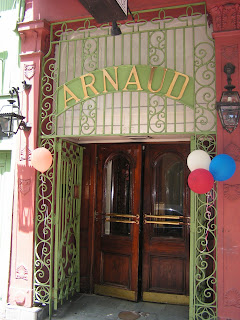Germaine married Barkley Wells and they had a daughter, Arnaud Cazenave ().
 From the Arnaud's website:
From the Arnaud's website:Only New Orleans could produce a Germaine Cazenave Wells. She was lusty, dramatic, loud and headstrong. Her taste and capacity for alcohol, celebration and men were extreme, even by the standards of today. She worshiped her father; the pair were certainly kindred spirits. Everywhere she went, newspaper stories followed, always including accolades for Arnaud's. In New Orleans, a city full of characters, she achieved one-name status. During the Fifties and Sixties (and still, among people of a certain age), if you referred to "Germaine," everyone knew who you were talking about. She took to the mock-royal rituals of Mardi Gras like a fish to water. She ruled over 22 Carnival balls, an over achievement unlikely to be equaled. She instituted a parade of her own on Easter Sunday to show off her latest hats, with her friends following in horse-drawn buggies. That pageant continued after Germaine's death and persists to this day.
Germaine passed away in New Orleans on December 14, 1983, at the age of 81.
 In 1918, a colorful French wine salesman named Arnaud Cazenave opened the grand restaurant that bears his name. Count Arnaud (as he came to be called, without any bona fide claim to the title) practiced a brilliant new approach to the serving of food and drink. He became so influential in his business that it can be said that the entire New Orleans restaurant community reflects, to one degree or another, his ideas. And the style he set inspires everything we do to this day at Arnaud's.
In 1918, a colorful French wine salesman named Arnaud Cazenave opened the grand restaurant that bears his name. Count Arnaud (as he came to be called, without any bona fide claim to the title) practiced a brilliant new approach to the serving of food and drink. He became so influential in his business that it can be said that the entire New Orleans restaurant community reflects, to one degree or another, his ideas. And the style he set inspires everything we do to this day at Arnaud's.

